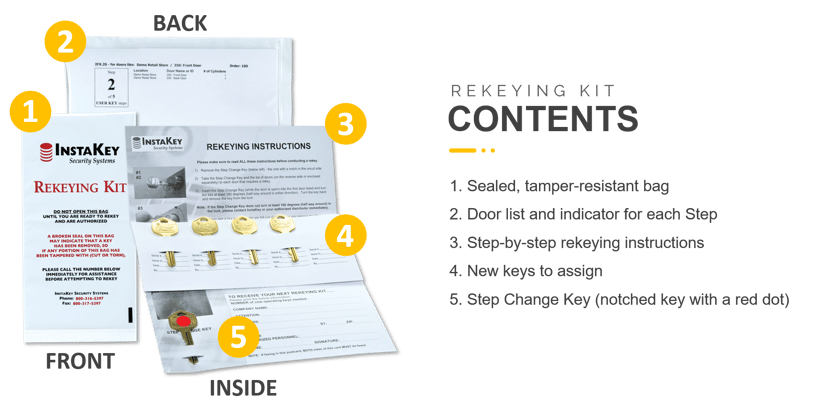How to Maximize Security & Profitability with Key Control for Cannabis

Some governing bodies of the most heavily regulated industries, like legal cannabis, fail to include proactive key management as part of the comprehensive facility security requirements, leaving it up to business owners themselves to make key control part of their culture to keep assets secure and business profitable. Unfortunately, most cannabis businesses opt for the cheapest locks available, without being aware of or considering the long-term implications for spending required to keep a key system secure.
Controlling keys in a way that supports profitability is usually unheard of. Locks and keys just keep things secure, and that’s it. If this aligns with what you think locks and keys can do, you might want to think again at the end of this article. Here’s eight tips to help you maximize security and profitability using better key control.
1. Use Restricted Keys
Restricted keys can’t be copied. They can't be copied because the key blanks required to make copies are not available where keys would be copied (locksmiths, hardware stores, key copying kiosks, etc.). The best security plans include these keys because when they are returned by separating key holders, an extra key won’t exist, eliminating a possible security breach. This is the most important component in key control. Not only is this an enhancement to traditional keyed security, its also a measure to reduce costs. When keys are returned in employee turnover, there is no need to rekey (change the locks), saving a couple hundred dollars each time a rekey is avoided. In high turnover industries like Cannabis, this could be very meaningful to the profitability of a business.
2. Key Receipts
Maintain key holder compliance by requiring a signature for acknowledgement of each key issued. Key receipts document the key holder, the keys in custody and the agreement between the key holder and employer regarding procedures and expectations for key custody and lost keys. As an increased security measure, consider penalizing key holders in some way, for losing keys.
Key receipts do not have to be done on paper. There is a digital method that is more efficient and eco-friendly allowing users to assign keys, get key receipt signoff and update key holder records remotely.
3. Use Rekeyable Locks
When keys can’t be reclaimed from separating key holders, avoid risking employee safety and product security, which is threatened when you have to wait for a locksmith. Rekey locks yourself, immediately. This can be done with user-rekeyable cylinders that require no tools or hardware removal to rekey. A Step Change Key is all that is needed. User-rekeyable cylinders can be rekeyed nine times before a core needs to be swapped out for another nine rekeys. This can save a considerable amount of money on locksmith services. A locksmith visit averages $200 per visit, where a Rekeying Kit, to change the locks immediately, averages around $40. That can make a big difference to the bottom line if you have high key holder turnover requiring several rekeys at one location annually.
4. Keep a Backup Rekeying Kit
After conducting a rekey, make sure a new Rekeying Kit is ordered to keep on-site, in a secure location. A safe is the perfect place. This will make it easy to conduct the next rekey and distribute new keys without delay. Rekeying kits include everything needed to quickly re-secure a location (including which locks need a rekey and how to conduct a rekey) and give access to key holders.

5. Get a Key Control Database to Keep Records
You’ll want to keep track of relationships between keys, key holders & locks, using unique identifiers on keys, or serial numbers. This should be done in a cloud-based, centralized, secure key control database to give visibility to administrators for auditing purposes. Keeping key system records on paper or by other means is time consuming and prone to errors. And, if you ever need to provide a list of who has access to what, for compliance or regulatory purposes, exporting this data is as easy as a few clicks or taps on a smart device.
6. Audit Keys and Key Holders
To keep the security and integrity of a key system, it should be audited at least once a quarter. Diligent security programs should conduct these audits monthly to ensure that issued keys stay with the intended key holders. Again, this can be done with paper records, but more advanced methods of auditing keys and key holders exist, making it possible to audit remotely with the use of smart devices. Audits are intended to verify more than just who has what keys. If key holders aren't able to list the keys in their possession, a key may be lost and rekeying is recommended.
7. Try a Master Key System
Using a master (grandmaster or a great grandmaster) key in your key control system can help to limit access to areas requiring higher authorization without employees needing to carry around several keys. Managing access in a hierarchy reduces the overall number of keys to keep track of, as one master level key accesses all levels. With user-rekeyable locks, if a master level key is unaccounted for, rekeying can be done on the master level without affecting user level access or keys - saving time and a lot of money. With traditional master key systems, when a master key is lost, the entire key system will need to be rekeyed, resulting in a major cost to the business.
8. Find a Partner
Of course, you’ll want to find a physical security expert to help you develop a customized plan for each commercial-grade lock, what type of hardware should be used & where it should be used appropriately. Any hardware expert can advise on how or why to do something for security, but a partner in key control will make it a mission to take care of a project as if it were their own.
Locks and keys can be more than just brass that keeps your facility secure. They can be a real source of cost-savings and improved operational efficiency. So, go above and beyond required security regulations. You’ll save a ton of time and money in the process – and keep your cannabis business growing.






